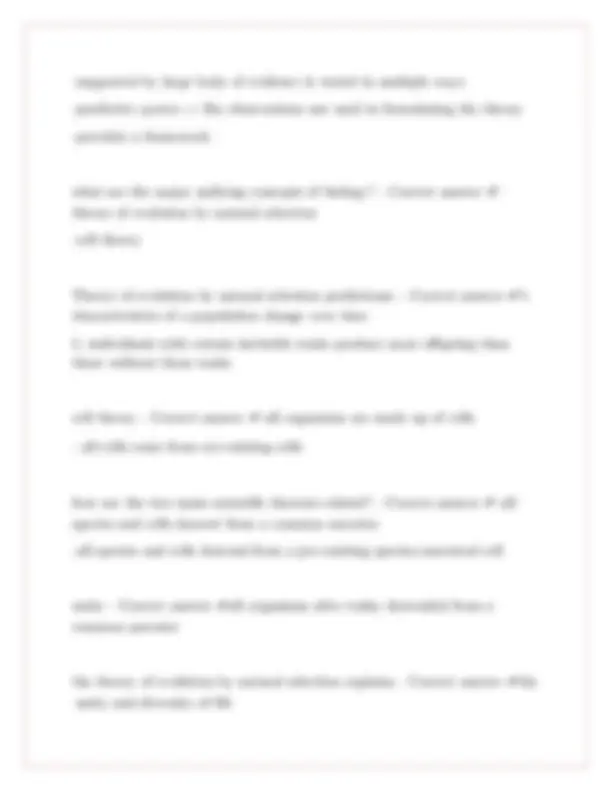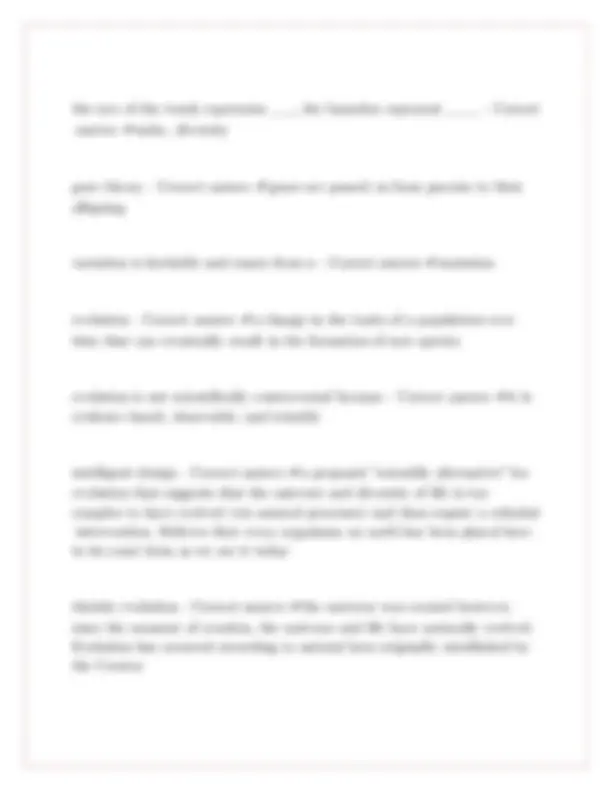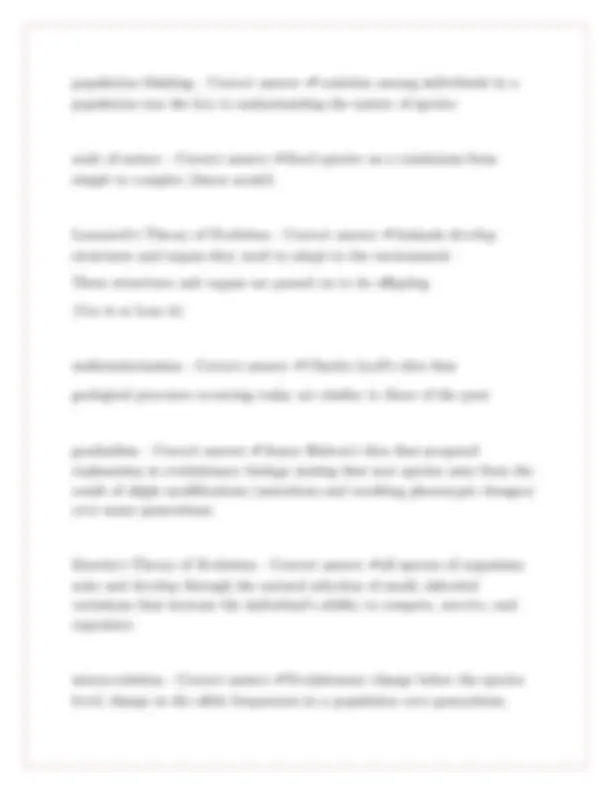



























Study with the several resources on Docsity

Earn points by helping other students or get them with a premium plan


Prepare for your exams
Study with the several resources on Docsity

Earn points to download
Earn points by helping other students or get them with a premium plan
Community
Ask the community for help and clear up your study doubts
Discover the best universities in your country according to Docsity users
Free resources
Download our free guides on studying techniques, anxiety management strategies, and thesis advice from Docsity tutors
BIOL 1001 Exam with precise detailed solutions
Typology: Exams
1 / 33

This page cannot be seen from the preview
Don't miss anything!


























What |! is |! science? |! - |! Correct |! answer |! ✔a |! process |! for |! understanding |! the |! natural/ |! observable |! world Hypothesis: |! excess |! acid |! was |! proposed |! as |! a |! cause |! of |! ulcers. |! How |! would |! you |! test |! the |! "excess |! acid" |! hypothesis |! effectively? a. |! examine |! ulcer |! patients |! of |! a |! range |! of |! ages |! and |! measure |! their |! stomach |! acid |! levels b. |! have |! all |! volunteers |! drink |! alcohol |! and |! measure |! their |! stomach |! acid |! levels c. |! lower |! stomach |! acid |! of |! some |! volunteers |! (using |! drugs/antacids) |! and |! measure |! numbers |! of |! ulcers |! in |! all |! volunteers |! d. |! examine |! patients |! of |! a |! range |! of |! ages |! and |! measure |! the |! number |! of |! ulcers |! in |! each |! person e. |! put |! all |! volunteers |! through |! a |! stress |! test |! and |! then |! measure |! their |! stomach |! acid |! levels |! - |! Correct |! answer |! ✔c.
process |! of |! science |! - |! Correct |! answer |! ✔-iterative -not |! pre-determined -has |! many |! starting |! points -rooted |! in |! testing -involves |! feedback/ |! scrutinizing |! ideas -influences, |! and |! is |! influenced |! by |! society hypothesis |! - |! Correct |! answer |! ✔a |! proposed |! explanation |! that |! leads |! to |! a |! testable |! prediction empirical |! - |! Correct |! answer |! ✔based |! on |! experience |! and |! observations |! that |! are |! rational, |! testable, |! and |! repeatable scientific |! idea |! + |! expectations |! + |! observations= |! - |! Correct |! answer |! ✔scientific |! argument the |! scientific |! method |! is |! _____________ |! therefore, |! the |! word |! PROVE |! cannot |! be |! used |! - |! Correct |! answer |! ✔self-correcting If |! the |! results |! of |! the |! excess |! acid |! hypothesis |! are |! true, |! which |! graph |! most |! closely |! matches |! the |! predicted |! results? A. |! high |! treatment |! group, |! low |! control |! group B. |! low |! treatment |! group, |! high |! control |! group C. |! both |! groups |! high
-supported |! by |! large |! body |! of |! evidence |! & |! tested |! in |! multiple |! ways -predictive |! power--> |! fits |! observations |! not |! used |! in |! formulating |! the |! theory -provides |! a |! framework what |! are |! the |! major |! unifying |! concepts |! of |! biology? |! - |! Correct |! answer |! ✔- theory |! of |! evolution |! by |! natural |! selection -cell |! theory Theory |! of |! evolution |! by |! natural |! selection |! predictions: |! - |! Correct |! answer |! ✔1. |! characteristics |! of |! a |! population |! change |! over |! time
the |! tree |! of |! the |! trunk |! represents |! _____, |! the |! branches |! represent |! _______ |! - |! Correct |! answer |! ✔unity, |! diversity gene |! theory |! - |! Correct |! answer |! ✔genes |! are |! passed |! on |! from |! parents |! to |! their |! offspring variation |! is |! heritable |! and |! comes |! from |! a |! - |! Correct |! answer |! ✔mutation evolution |! - |! Correct |! answer |! ✔a |! change |! in |! the |! traits |! of |! a |! population |! over |! time |! that |! can |! eventually |! result |! in |! the |! formation |! of |! new |! species evolution |! is |! not |! scientifically |! controversial |! becuase |! - |! Correct |! answer |! ✔it |! is |! evidence |! based, |! observable, |! and |! testable intelligent |! design |! - |! Correct |! answer |! ✔a |! proposed |! "scientific |! alternative" |! for |! evolution |! that |! suggests |! that |! the |! universe |! and |! diversity |! of |! life |! is |! too |! complex |! to |! have |! evolved |! (via |! natural |! processes) |! and |! thus |! require |! a |! celestial |! intervention. |! Believes |! that |! every |! organisms |! on |! earth |! has |! been |! placed |! here |! in |! its |! exact |! form |! as |! we |! see |! it |! today theistic |! evolution |! - |! Correct |! answer |! ✔the |! universe |! was |! created |! however, |! since |! the |! moment |! of |! creation, |! the |! universe |! and |! life |! have |! naturally |! evolved. |! Evolution |! has |! occurred |! according |! to |! natural |! laws |! originally |! established |! by |! the |! Creator
Algae |! in |! the |! genus |! Caulerpa |! typically |! grow |! to |! a |! length |! of |! over |! half |! a |! metre |! and |! have |! structures |! similar |! to |! stems, |! leaves, |! and |! roots. |! Reproduction |! occurs |! when |! adults |! produce |! sperm |! and |! eggs |! that |! fuse |! to |! form |! offspring |! Each |! adult |! Caulerpa, |! however, |! consists |! of |! just |! a |! single |! cell. |! Which |! of |! the |! following |! statements |! is |! true? |! - |! Correct |! answer |! ✔Caulerpa |! is |! consistent |! with |! the |! cell |! theory. ow |! is |! hunting |! affecting |! the |! bighorn |! sheep |! populations |! in |! Alberta? |! - |! Correct |! answer |! ✔There |! has |! been |! selection |! against |! large |! body |! size; |! consequences |! of |! this |! are |! unknown. to |! run |! a |! controlled |! experiment |! what |! parameters |! must |! be |! held |! constant? |! - |! Correct |! answer |! ✔all |! except |! the |! variable |! being |! measured Evolution |! by |! natural |! selection |! depends |! on |! - |! Correct |! answer |! ✔individuals |! having |! heritable |! traits |! that |! provide |! some |! advantage |! to |! individuals |! with |! them |! compared |! to |! individuals |! without. The |! experiment |! by |! Pasteur |! involving |! the |! swan-neck |! and |! open |! flasks |! had |! a |! good |! design |! because |! - |! Correct |! answer |! ✔the |! possible |! outcomes |! led |! to |! distinct, |! unambiguous |! conclusions. Which |! of |! the |! following |! is |! the |! best |! example |! of |! heritable |! variation? a. |! amputation b. |! natural |! red |! hair c. |! love |! for |! music
d. |! skin |! cancer |! - |! Correct |! answer |! ✔b hypotheses |! can |! be |! proven |! - |! Correct |! answer |! ✔false, |! can |! only |! be |! supported/ |! falsified null |! hypothesis |! - |! Correct |! answer |! ✔the |! hypothesis |! that |! there |! is |! no |! significant |! difference |! between |! specified |! populations, |! any |! observed |! difference |! being |! due |! to |! sampling |! or |! experimental |! error. evidence |! - |! Correct |! answer |! ✔the |! available |! body |! of |! facts |! or |! information |! indicating |! whether |! a |! belief |! or |! proposition |! is |! true |! or |! valid. proof |! - |! Correct |! answer |! ✔evidence |! or |! argument |! establishing |! or |! helping |! to |! establish |! a |! fact |! or |! the |! truth |! of |! a |! statement belief |! - |! Correct |! answer |! ✔ accept |! - |! Correct |! answer |! ✔ function |! - |! Correct |! answer |! ✔ purpose |! - |! Correct |! answer |! ✔
Darwin |! & |! Wallace's |! theory |! of |! evolution |! by |! natural |! selection |! was |! revolutionary |! because |! - |! Correct |! answer |! ✔it |! emphasized |! the |! importance |! of |! variation |! and |! change |! in |! populations theory |! of |! evolution |! by |! natural |! selection |! - |! Correct |! answer |! ✔-characteristics |! of |! a |! population |! change |! over |! time -individuals |! with |! certain |! heritable |! traits |! produce |! more |! offspring |! than |! those |! without |! those |! traits phylogenetic |! trees |! show |! that |! - |! Correct |! answer |! ✔-life |! on |! earth |! has |! changed |! over |! time -different |! species |! share |! common |! ancestors lineage |! - |! Correct |! answer |! ✔sequence |! of |! species |! that |! form |! line |! of |! descent phylogenies |! represent |! - |! Correct |! answer |! ✔hypotheses |! about |! evolutionary |! relationships |! and |! are |! revised |! according |! to |! new |! info when |! does |! a |! split |! occur |! in |! a |! phlogenetic |! tree |! - |! Correct |! answer |! ✔when |! the |! ancestral |! lineage |! divides |! into |! two |! descendant |! lineages Phenotypic |! traits |! are |! based |! on |! 2 |! things: |! - |! Correct |! answer |! ✔genetics |! & |! environment a |! common |! ancestor |! is |! - |! Correct |! answer |! ✔an |! ancestral |! organism |! shared |! by |! two |! or |! more |! descendant |! organisms
speciation |! event |! - |! Correct |! answer |! ✔A |! point |! in |! evolutionary |! history |! at |! which |! a |! given |! population |! splits |! into |! independent |! evolutionary |! lineages. Fossil |! - |! Correct |! answer |! ✔Any |! trace |! of |! an |! organism |! that |! lived |! in |! the |! past evidence |! that |! species |! change |! through |! time |! - |! Correct |! answer |! ✔- |! fossils |! (extinct |! species |! resemble |! extant |! species |! in |! same |! area, |! transitional |! fossils) -evidence |! of |! living |! species |! changing |! (insecticide |! & |! antibiotic |! resistance) evidence |! of |! common |! ancestry |! - |! Correct |! answer |! ✔-transitional |! fossils -homology |! (vestigial |! traits) -artificial |! selection -biogeography transitional |! fossils |! - |! Correct |! answer |! ✔Fossils |! that |! provide |! patterns |! of |! evolutionary |! change |! from |! the |! early |! ancestors |! to |! modern |! life |! forms. vestigial |! traits |! - |! Correct |! answer |! ✔Traits |! that |! were |! useful |! in |! ancestors |! that |! are |! inherited |! today, |! but |! that |! have |! lost |! their |! original |! use. in |! which |! of |! the |! following |! habitats |! would |! you |! most |! expect |! a |! fossil |! to |! form? a. |! deser
-temporal |! bias -abundance |! bias temporal |! bias |! - |! Correct |! answer |! ✔more |! recent |! fossils |! are |! more |! common |! than |! ancient |! fossils abundance |! bias |! - |! Correct |! answer |! ✔Organisms |! that |! are |! abundant, |! widespread, |! and |! present |! on |! Earth |! for |! a |! long |! time |! leave |! evidence |! much |! more |! often |! than |! do |! species |! that |! are |! rare, |! local, |! or |! ephemeral sediment |! forms |! in |! what |! type |! of |! environment? |! - |! Correct |! answer |! ✔aquatic many |! fossils |! are |! found |! here |! but |! not |! formed |! here |! - |! Correct |! answer |! ✔mountains taxonomic |! bias |! - |! Correct |! answer |! ✔organisms |! with |! hard |! parts |! are |! more |! likely |! to |! leave |! fossils why |! was |! the |! theory |! of |! evolution |! by |! natural |! selection |! revolutionary? |! - |! Correct |! answer |! ✔1. |! overturned |! the |! idea |! that |! species |! are |! static |! and |! unchanging
population |! thinking |! - |! Correct |! answer |! ✔variation |! among |! individuals |! in |! a |! population |! was |! the |! key |! to |! understanding |! the |! nature |! of |! species scale |! of |! nature |! - |! Correct |! answer |! ✔fixed |! species |! on |! a |! continuum |! from |! simple |! to |! complex |! (linear |! model) Larmarck's |! Theory |! of |! Evolution |! - |! Correct |! answer |! ✔Animals |! develop |! structures |! and |! organs |! they |! need |! to |! adapt |! to |! the |! environment These |! structures |! and |! organs |! are |! passed |! on |! to |! its |! offspring |! (Use |! it |! or |! Lose |! it) uniformitarianism |! - |! Correct |! answer |! ✔Charles |! Lyell's |! idea |! that |! geological |! processes |! occurring |! today |! are |! similar |! to |! those |! of |! the |! past. gradualism |! - |! Correct |! answer |! ✔James |! Hutton's |! idea |! that |! proposed |! explanation |! in |! evolutionary |! biology |! stating |! that |! new |! species |! arise |! from |! the |! result |! of |! slight |! modifications |! (mutations |! and |! resulting |! phenotypic |! changes) |! over |! many |! generations. Darwin's |! Theory |! of |! Evolution |! - |! Correct |! answer |! ✔all |! species |! of |! organisms |! arise |! and |! develop |! through |! the |! natural |! selection |! of |! small, |! inherited |! variations |! that |! increase |! the |! individual's |! ability |! to |! compete, |! survive, |! and |! reproduce. microevolution |! - |! Correct |! answer |! ✔Evolutionary |! change |! below |! the |! species |! level; |! change |! in |! the |! allele |! frequencies |! in |! a |! population |! over |! generations.
A |! human |! forearm, |! a |! horse's |! front |! leg, |! a |! bat's |! wing, |! and |! a |! porpoise's |! flipper |! have |! similar |! bone |! structure. |! What |! conclusions |! can |! we |! draw |! from |! the |! similarities |! in |! bone |! structure |! between |! these |! mammals? |! - |! Correct |! answer |! ✔Similarities |! among |! vertebrate |! forelimbs |! suggest |! they |! evolved |! from |! a |! common |! ancestor. Why |! was |! Darwin |! and |! Wallace's |! theory |! of |! evolution |! by |! natural |! selection |! revolutionary? |! - |! Correct |! answer |! ✔It |! dismissed |! the |! idea |! species |! are |! unchanging, |! and |! emphasized |! the |! importance |! of |! variation |! and |! change |! in |! populations. Why |! is |! burial |! a |! key |! step |! in |! fossilization? |! - |! Correct |! answer |! ✔-slows |! the |! process |! of |! decay |! by |! bacteria |! and |! fungi
Why |! is |! the |! fossil |! record |! incomplete? |! - |! Correct |! answer |! ✔-Geologic |! processes |! may |! destroy |! fossils. -Organisms |! tend |! to |! decay |! before |! becoming |! a |! fossil. -Only |! a |! fraction |! of |! organisms |! were |! preserved |! as |! fossils. -Animals |! with |! hard |! parts |! are |! preserved |! more |! easily. where |! are |! the |! oldest |! rock |! layers |! located? |! - |! Correct |! answer |! ✔underneath |! younger |! layers |! (law |! of |! superposition) what |! are |! the |! two |! ways |! of |! dating |! fossils? |! - |! Correct |! answer |! ✔-absolute |! (radioactivity) -relative absolute |! (radioactive) |! dating |! - |! Correct |! answer |! ✔method |! of |! determining |! the |! age |! of |! a |! fossil |! by |! using |! the |! half-life |! of |! radioactive |! elements |! found |! in |! the |! fossil; |! based |! on |! the |! decay |! rates |! of |! parent |! to |! daughter |! atoms; |! only |! for |! igneous |! rocks relative |! dating |! - |! Correct |! answer |! ✔any |! method |! of |! determining |! whether |! an |! event |! or |! object |! is |! older |! or |! younger |! than |! other |! events |! or |! objects; |! relative |! to |! ages |! in |! the |! geologic |! time |! scale; |! determined |! by |! using |! the |! idea |! of |! superposition |! (position |! of |! one |! layer |! of |! rock |! compared |! to |! another)
descent |! with |! modification |! - |! Correct |! answer |! ✔principle |! that |! each |! living |! species |! has |! descended, |! with |! changes, |! from |! other |! species |! over |! time artificial |! selection |! provides |! evidence |! of |! - |! Correct |! answer |! ✔descent |! with |! modification artificial |! selection |! - |! Correct |! answer |! ✔Selection |! by |! humans |! for |! breeding |! of |! useful |! traits |! from |! the |! natural |! variation |! among |! different |! organisms why |! do |! we |! find |! some |! species |! in |! only |! specific |! locations? |! - |! Correct |! answer |! ✔due |! to |! continental |! drift biogeogrpahy |! - |! Correct |! answer |! ✔more |! similar |! species |! tend |! to |! be |! found |! in |! the |! same |! geographic |! areas where |! are |! homologous |! features |! found |! on |! a |! phylogenetic |! tree? |! - |! Correct |! answer |! ✔at |! the |! bottom |! of |! the |! tree |! (in |! most |! related |! common |! ancestor) evidence |! of |! descent |! with |! modification |! through |! time |! - |! Correct |! answer |! ✔- |! extinction -transitional |! forms -homologies -change |! in |! pops |! of |! living |! organisms |! correlate |! with |! changes |! in |! environment
differences |! in |! homologous |! structures |! reflect |! ______ |! of |! a |! common |! feature |! - |! Correct |! answer |! ✔remodelling homologous |! structures |! can |! have |! - |! Correct |! answer |! ✔the |! same |! of |! different |! structures analogous |! - |! Correct |! answer |! ✔similar similarity |! is |! not |! always |! - |! Correct |! answer |! ✔homology convergent |! evolution |! - |! Correct |! answer |! ✔similar |! traits |! in |! organisms |! facing |! similar |! changes homologous |! evolution |! - |! Correct |! answer |! ✔A |! trait |! is |! shared |! because |! it |! belonged |! to |! a |! common |! ancestor |! e.g. |! opposable |! thumbs how |! can |! we |! tell |! if |! a |! trait |! is |! homologous? |! - |! Correct |! answer |! ✔-components |! have |! the |! same |! basic |! structure |! in |! same |! relationship |! to |! other |! features -same |! developmental |! process -similar |! genetic |! sequences why |! does |! relative |! dating |! of |! fossils |! have |! limited |! use? |! - |! Correct |! answer |! ✔- |! it |! does |! not |! provide |! us |! with |! absolute |! numerical |! dates